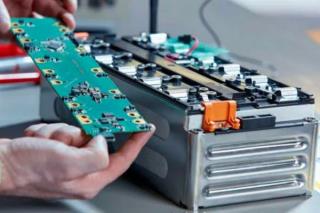
CODESOLAR
ENERGIA S.A.
ESN
Electric transport

What plans does Latin America have to recycle vehicle batteries?
Although there is still a lot to do in terms of battery recycling regulations, compared to other continents, some countries in the region are already addressing this issue. Which are?
Due to the lack of a productive circuit for batteries in Latin America, in the first instance they focus on the elimination of environmental liabilities, and then progressively introduce circular economy options.
The rise of electric vehicles poses an urgent challenge for the entire region: the effective management of their battery waste.
This growing concern has begun to prompt some States to commit to effective recycling policies.
Some Latin American countries have already implemented measures in this regard, recognizing the importance of properly managing battery waste to ensure long-term sustainable development.
However, it is worth noting that China, as well as Europe, are more advanced on this issue.

Vehiculos Electricos EV
Articulos
Video - Fotos
Equipos Solar Electricos Transportacion EV
CodeSolarEnergia S. A.
Comunicacion Desarrollo Tecnologia Energia Solar
Quito, Ecuador, Sudamerica

Costa Rica
Costa Rica is one of the countries that has made the greatest progress.
In line with this, it created a roadmap for the efficient management of electric vehicle batteries, with the aim of developing a plan to reduce and control technical and non-technical losses.
It identifies three options for waste management: recovery through reuse, direct recycling or export.
On the other hand, short, medium and long-term goals are established, such as managing 60% of lithium battery waste by 2030, prioritizing reuse and updating the national regulatory framework.
In the medium term, the aim is to recover at least 75% of the lithium batteries available for recycling and consolidate reuse as a methodology for recovery in the country.
Colombia
In Colombian territory, the importance of regulating the use and disposal of electric batteries has also begun to be considered.
The National Electric Mobility Strategy (ENME) of Colombia, published in 2021, establishes that the Ministry of Environment and Sustainable Development (MADS) must define the guidelines and proposed regulations necessary for the disposal of electric vehicles and their components, including batteries. but there are no specific regulations in force yet.
Bogotá promotes a circular economy model of electric batteries
In July 2023, the capital published the Zero and Low Emissions Motorized Mobility Public Policy, which contemplates the time gap between 2023 and 2040.
One of its main pillars seeks to promote a circular economy model for electric batteries.
The purpose associated with this strategic factor is to have a model that involves technological innovation, collaboration between actors and the creation of new business models.
This is part of an objective that seeks to strengthen management, innovation, development and research processes in the value chain of technologies for zero and low emissions motorized mobility.
Chile
Although there is still no specific law for the recycling of electric transport batteries, it is a topic addressed in the National Electromobility Strategy in the point referring to Circular Economy and Transformation.
There it is detailed that the regulations to be developed will consider the principles contemplated by the law on gradualness and hierarchy in waste management, which has prevention as its first option, then reuse, then recovery and, lastly, elimination.
This will lead to establishing incentives associated with reuse, which in this case would imply that batteries extracted from different means of transportation can be used for other purposes, generating a formal and established market.
In relation to this, the Energy Sustainability Agency (AgenciaSE) published the tender “Background for the preparation of economic and social analysis of collection and recovery goals for the priority product “Lithium ion batteries” contained in law 20,920 - REP Law - and promotion of electromobility in regions of the country.”
The objective of this study is to support the Ministry of the Environment (MMA) in the development of the necessary regulations to promote the development and adoption of sustainable practices in the management of end-of-use batteries from electromobility in Chile.
Mexico
Like the states mentioned above, Mexico also intends to establish regulations that promote the recycling of electric batteries.
That is why the draft of the National Electric Mobility Strategy was created, which was released in June 2023 by the Ministry of the Environment and Natural Resources (SEMARNAT), and contemplates the regulation of batteries, as well as their recycling and possibility of second life.
A short-term action is to promote, in collaboration with local authorities and the automotive industry, the creation of an Official Mexican Standard that establishes reuse, management and final disposal plans.
This regulation must define guidelines regarding their useful life, procedures for their collection, promote their second use and facilitate their recycling.
Europe
In July 2023, the European Union published in its Official Journal Regulation (EU) 2023/1542 of the European Parliament and of the Council regarding batteries and their waste and amending Directive 2008/98/EC and Regulation (EU) 2019/1020 and Directive 2006/66/EC is repealed.
The objective is to avoid and reduce the adverse impacts of cells or batteries on the environment and guarantee a safe and sustainable value chain for all of them.
In that sense, it should apply to all categories placed on the market or put into service in the Union, regardless of whether they were produced there or imported.
Although it is not a 100% specific regulation for electric vehicles, it does highlight special considerations for the segment.
In fact, it recategorizes this type of batteries, and even makes a differential for those for light transport such as electric bicycles or scooters.
Furthermore, the European Commission launched the European Battery Alliance in 2017 to create a complete, globally competitive and sustainable battery value chain in the EU.
Esto formaba parte de un objetivo más amplio: el de garantizar la autonomía estratégica en un sector que es fundamental para la transición ecológica y digital de la economía europea.
La Alianza ha proporcionado un marco que reúne a la Comisión, los Estados miembros, el Banco Europeo de Inversiones y los agentes de la industria y la innovación para trabajar en una agenda conjunta.
Fuente: https://mobilityportal.lat/planes-para-las-baterias-de-los-vehiculos/
In the long term, the aim is to achieve a 100% recycling rate, prioritizing reuse and establishing specialized recycling pilot projects.
In addition, it is proposed to establish access restrictions to the country for electric vehicle batteries according to their manufacturing practices.
The country's first intentions of regulatory practices had good results.
Last December, FORTECH inaugurated the first battery recycling plant for electric vehicles in Central America in Costa Rica.
It has the capacity to process 1,000 tons per year, which is equivalent to approximately 2,000 electric car batteries.
''Costa Rica is positioned as a leader in lithium recycling technology, addressing a local and global problem. “We are exploring bringing this solution to other regions where the challenge of safe battery accumulation and transport is growing,” says Claus Kruse, project director at GIZ.
USA
As is the case with Latin American countries, the United States does not have a specific national law for electric vehicle batteries.
However, it has launched programs and investments that facilitate its recycling and second life processes.
In June 2023, the US Department of Energy (DOE) announced an investment of more than US$192 million in new funding for recycling batteries from consumer products, launching an advanced research and development consortium ( R&D) and the continuation of recycling.
Puerto Rico
In December 2022, the alternate spokesperson for the New Progressive Party, Carmelo Ríos, assured that the Federal Department of Transportation has $300 million to develop a study on the final disposal of batteries discarded in electric vehicles.
It is worth mentioning that in Latin America there is still a long way to go in terms of battery recycling. But what happens on the other side of the world?
China
The People's Republic of China is home to both the world's largest battery market and the world's largest battery recycling market.
This is why the Ministry of Industry and Information Technology (MIIT) ensures that its new directives on battery reuse and recycling will ensure greater environmental protection, improve resource utilization and ensure the healthy development of the vehicle industry. of new energy.
This not only makes sense for geopolitical and environmental reasons, but also because the MIIT perceives battery reuse and recycling to be big business.
Some estimates predict that the battery recycling market in China will reach €3.59 billion by 2025, but figures for the market value and volume of recycling in this country vary greatly.
